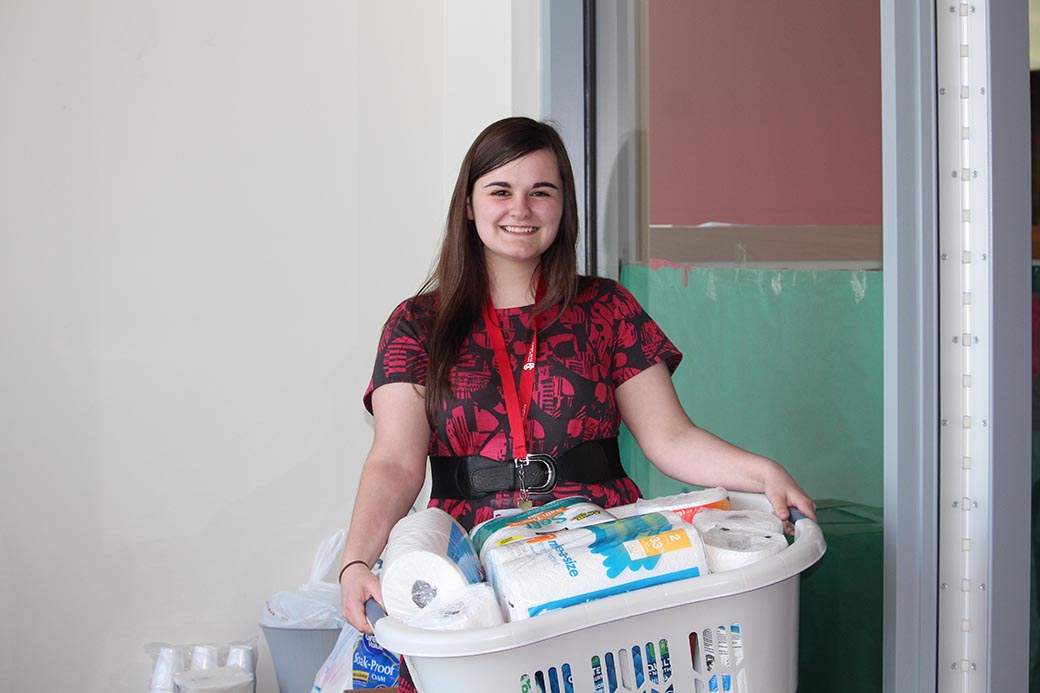
K-9 officer Reno entertains and educates Girls Staters; demonstrates the importance of canines in police forces
By Addy Nelson, Sacajawea Scroll
Girls State delegates awed over two canines Thursday afternoon and learned important information while they were at it.
Girls Staters attended the K-9 demonstration in Aalfs Auditorium Slagle Hall.
From the Yankton Police Department Sgt. Jason Foote, Officer Pat Nolz and Officer Kyler Pekarek conducted a demonstration to explain why the dogs are needed and to clear up misconceptions about the dogs use among the police force.
Officers explained a K-9 procedure called drug detection. Drug detection has two steps: odor training and apprehension. Odor training starts with two weeks of scent memorization. This entails keeping drug odor constant with different types of smells along with them.
The dogs and their owner are then tested. Next, the pair goes through six weeks of search patterns where the canine is taught how to look for drugs and cover ground.
Throughout the eight weeks, Nolz said the handler is tested along with the dog. Both go through extensive procedures to prepare them for the work force.
Canines are taught to sniff out methamphetamine, marijuana, cocaine, heroine and ecstasy, Foote said. Dogs are taught to find criminals and sniff out any object.
Some dogs know special tricks like how to open a car door or find criminals without a command, according to the police officers.
Dogs like Max and Reno, used in the Thursday demonstration, are working dogs. They can break a leg and continue working as if nothing happened, Nolz said.
Some do wear stab and bulletproof vests, according to Pekarek. The Yankton Police Force handler’s take care of their dogs and take them home.
Dogs only sweat through their tongue and their pads of their feet so often become too hot, Pekarek added.
“I thought it was really helpful to understand that the dogs are actually there to help. People get really scared of the dogs, but they’re pretty helpful,” said Victoria Olson, a delegate from St. Louis.
Canines can be trained with two different behaviors, too: passive indication or active alert, the officers said. The Yankton Police Department utilizes passive indication where dogs sit, poke and hold the indicated object. Active alert is where dogs bite, bark or scratch at the indicated object.
“I learned more about all the work it takes to have one and what you have to put into it,” said Emily Foiles, Baltimore delegate.
The Yankton police have two Belgian Malinois. Canine Max, Handled by Officer Pat Nolz, and canine Reno, handled by Officer Kyler Pekarek.
These canines come from Europe and are expensive. According to the presenters, officers command each dog in their foreign language. This makes it so spectators don’t know what the officers are saying as well.
They don’t attack unless attacked first, Pekarek said. Both dogs are taught apprehension, where they give the correct force needed to contain the object or person.
The dogs are chosen around the age of one to three. Officer canines work until around the age of eight to nine.
For retirement in the Yankton Police Department, the handlers are given the option to buy the dog for $1, Foote said. If an officer canine dies, a funeral is held.



